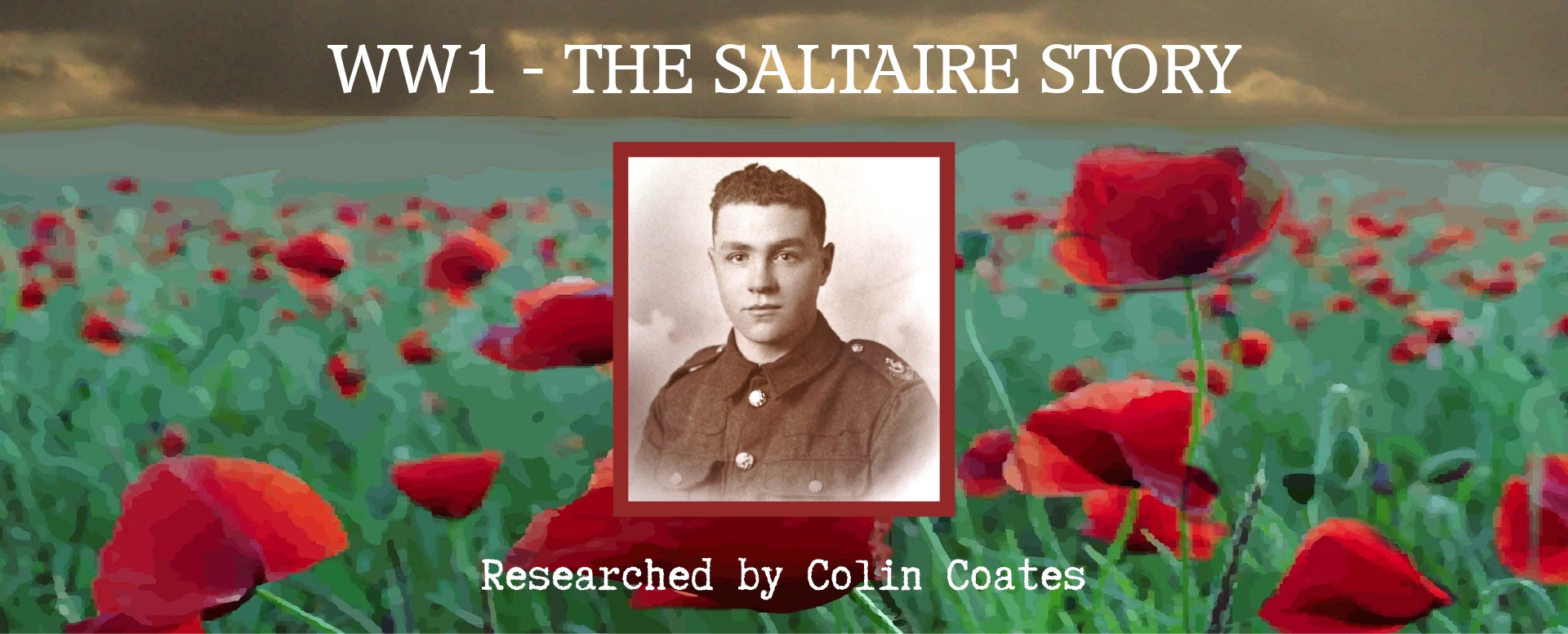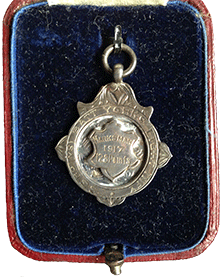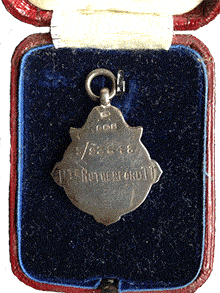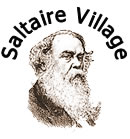 |
| Colin Coates |
|
|
| The BIG LIST |
|
|
|
| Reel Lives |
|
|
|
| Mill Workers |
|
|
| House Histories |
|
|
| Extra Biographies |
|
|
| News: 100 years ago |
|
|
| Second Boer War |
|
|
| WW1: Saltaire Story |
|
|
|
|
|
|
|
|
| WW2: Saltaire Story |
|
|
|
|
|
|
| Social History |
|
|
|
|
|
|
 | Home | WW1: The Saltaire Story | Snippets | Home | WW1: The Saltaire Story | Snippets |
| Image: Tom Thompson Middleton Rutherford |
|
|
|
WW1: The Saltaire Story
Researched by Colin Coates |
| |
SNIPPETS
Conscription categories in the Great War
Places of worship in Shipley area
Shipley Public Houses
Analysis of 1918 Electoral in Saltaire
Local breweries during WW1
Clark, Bert
Recruitment
House history of 3 Fern Place
HMS Aboukir
John R Fyfe & Co. Fire Brick Works, Shipley
Rutherford, Tom Thompson Middleton
Work at Salts Mill, December 1914: Booming!
Has Anyone Seen a German Band?
HMS Kent
Lord Derby’s Scheme
Three Armies
|
Conscription Categories in the Great War
On 27th January, 1916, the Military Service act became law, every man between the ages of 18 and 41, if unmarried, was 'deemed to have enlisted'. On 25th May, married men were 'deemed' to have done the same. The following categories were established:
A: General Service.
B1: Garrison Service Abroad.
B2: Labour Service Abroad.
B3: Sedentary Work Abroad.
C1: Garrison Service at Home Camps.
C2: Labour Service at Home Camps.
C3: Sedentary Service at Home Camps.
The Official History records the physical standards defining each category:
A: Able to march, see to shoot, hear well and stand active service conditions.
B: Free from serious organic diseases, able to stand service on the lines of communication in France, or in garrisons in the tropics.
B1: Able to march five miles, and see to shoot with glasses and hear well.
B2: Able to walk five miles to and from work, see and hear sufficiently for ordinary purposes.
B3: Only suitable for sedentary work.
C: Free from serious organic disease, able to stand service conditions in garrison at home.
In contemporary usage, a 'Category Man' was anyone assigned to a category below 'A'.
|
Places of Worship in the Shipley Area (Shipley, Windhill, Saltaire & Baildon)
Bradford Post Office Directory 1912
Bethel Baptist Chapel, Briggate
Christ Church, Windhill
Christian Church, Westcliffe Rd
Co-Operative Hall, Westgate
Independent Chapel, Leeds Rd
Independent Methodist Chapel, Baildon Green
Moravian Chapel, Wellfield, Baildon
Moravian Church, Browgate, Baildon
New Church Society (Swedenborgian), Saltaire Rd
Primitive Methodist Chapel, Cragg Rd
Primitive Methodist Chapel, Leeds Rd
Primitive Methodist Chapel, Moorside, Baildon
Primitive Methodist Chapel, Saltaire Rd
Rosse Street Baptist Church
Saltaire Congregational Church
Salvation Army Citadel, Rhodes Place
Shipley Congregational Church
St John’s Parish Church, Baildon
St Mary and Walburga’s Catholic Church, St Mary’s Avenue
St Paul’s Church, Kirkgate
St Peter’s Church, Moorhead Lane
Wesleyan Methodists Baildon Chapel, Westgate
Wesleyan Methodists Baildon Green
Wesleyan Methodists Charlestown Chapel
Wesleyan Methodists Saltaire Chapel, Saltaire Rd
Wesleyan Methodists Shipley Chapel, Otley Road
Wesleyan Methodists Windhill Mission, Briggate
Zion Primitive Methodist Chapel, Browgate, Baildon
|
Shipley Public Houses
Although there were no public houses in Saltaire, there was no shortage of them in Shipley. Here are the names and addresses of 28 public houses in Shipley as listed in the 1916 Bradford Post Office Directory:-
Airedale – 2 Otley Road
Alexandra – 68 Saltaire Road
Alma – Phoenix Street
Beehive – 1 Saltaire Road
Bradford Arms – 10 Otley Road
Bradford – 25 Valley Road
Branch – Bradford Road
Britannia – 130 Valley Road
Bull – 76 Briggate
Cambridge – 151 Otley Road
Cricketers Arms – 4 Westgate
Fleece – 12 Briggate
Fox & Hounds – 1 Commercial Street
Green Man – 451 Otley Road
Junction – 43 Westgate
New Inn – 124 Otley Road
Oddfellows Hall – Otley Road
Old House at Home – 69 Otley Road
Olive Branch – 37 Otley Road
Peel Park – 219 Otley Road
Prince of Wales – 60 Saltaire Road
Ring O’Bells – 1 Bradford Road
Rosse – 62 Bingley Road
Royal Oak – 52 Otley Road
Star & Garter – 10 Kirkgate
Sun – Market Place
Victoria – 100 Saltaire Road
Woodman – 58 Saltaire Road
|
| Analysis of 1918 Electoral Register in Saltaire
Colin Coates writes: I thought I would do an analysis of the 1918 Electoral to see what it tell us about Saltaire towards the end of the war. [6 July 2015]
The Representation of the People Act of 1918 granted the vote to women over the age of 30 who met a property qualification. The same Act gave the vote to all men over the age of 21. It also gave those in the Military the right to an absent vote.
In the 1918 Electoral Register Saltaire had 1788 voters across 947 houses
656 men at home
817 women
315 absent voters (all men serving in the Military/Navy)
So nearly 33% of the men eligible to vote were serving their country in the war.
Of the 947 houses:-
690 had no absent voters
212 had 1 absent voter
34 had 2 absent voters
9 had 3 absent voters
2 had 4 absent voters
352 houses had no male voters; 142 of these had an absent male voter(s).
The total of 315 serving men does not include those aged under 21. So the total number of men serving from Saltaire would have been higher.
Below, the figures broken down into streets.
M = Males at home; F= Females at home; ANM = Absent voters in the Navy/Miltary
| Street |
M |
F |
ANM |
Total |
| Ada St |
22 |
35 |
12 |
69 |
| Albert Rd |
37 |
34 |
20 |
91 |
| Albert Ter |
14 |
16 |
7 |
37 |
| Amelia St |
13 |
23 |
7 |
43 |
| Baker St |
18 |
14 |
6 |
38 |
| Bingley Rd |
16 |
20 |
1 |
37 |
| Boat House |
2 |
1 |
0 |
3 |
| Caroline St |
33 |
42 |
8 |
83 |
| Constance St |
19 |
28 |
14 |
61 |
| Daisy Place |
4 |
5 |
0 |
9 |
| Dove St |
36 |
38 |
14 |
88 |
| Edward St |
11 |
23 |
7 |
41 |
| Fanny St |
12 |
18 |
10 |
40 |
| Fern Place |
2 |
5 |
0 |
7 |
| George St |
69 |
68 |
37 |
174 |
| Harold Place |
6 |
6 |
2 |
14 |
| Helen St |
25 |
39 |
14 |
78 |
| Herbert St |
13 |
23 |
10 |
46 |
| Higher School St |
4 |
6 |
4 |
14 |
| Jane St |
21 |
21 |
18 |
60 |
| Katherine St |
11 |
14 |
7 |
32 |
| Lockwood St |
7 |
9 |
6 |
22 |
| Lower School St |
5 |
5 |
0 |
10 |
| Maddocks St |
21 |
22 |
16 |
59 |
| Mary St |
23 |
34 |
12 |
69 |
| Mawson St |
7 |
7 |
2 |
16 |
| Myrtle Place |
3 |
4 |
1 |
8 |
| Rhodes St |
46 |
43 |
21 |
110 |
| Saltaire Institure |
2 |
1 |
0 |
3 |
| Saltaire Mills House |
0 |
1 |
0 |
1 |
| Shirley St |
21 |
28 |
11 |
60 |
| Titus St |
39 |
52 |
12 |
103 |
| Victoria Rd |
51 |
71 |
20 |
142 |
| Victoria Ter |
2 |
2 |
0 |
4 |
| Whitlam St |
24 |
40 |
9 |
73 |
| William Henry St |
17 |
19 |
7 |
43 |
| Totals |
656 |
817 |
315 |
1788 |
Researched by Colin Coates
|
Local Breweries during World War One
Whilst Saltaire itself did not have a brewery, or a public house, there were numerous breweries in the locality:
J R Holmes & Sons – based in Bingley. Taken over by Hammonds Bradford Brewery in 1919 with 52 licensed houses.
Aaron King & Co – Old Brewery, Cook Lane, Keighley. Brewing ceased after 1946.
Timothy Taylor & Co Ltd – Knowle Spring Brewery, Keighley. Founded in 1858, registered in 1929. Still brewing independently in 2015.
Hammond’s Bradford Brewery Co Ltd – Fountain Brewery, Manchester Road, Bradford. James Hammond bought the Fountain Brewery in 1860 from Joseph Pullan, Joseph had inherited a malting’s from his father Thomas Pullan which Thomas had started in 1830, Joseph started brewing on the site in 1840. Brewing ceased in 1955.
J Hey & Co Ltd – Northbrook Brewery, Lumb Lane, Manningham. Registered in 1897. Taken over by Webster’s of Halifax in 1966 with 94 tied houses.
Horton Old Brewery Co Ltd - High Street, Horton. Registered in 1914. Brewing ceased c1935.
Joseph Spink & Sons Ltd – Brown Royd Brewery, Rosse Street, Bradford. Registered in 1889. Taken over by J Hey & Co Ltd in 1924
J & S Tordoff Ltd – Devonshire Arms Brewery, Thornton Road, Bradford. Registered in 1900. Taken over by J Hey & Co Ltd in 1919 and the brewery closed.
William Whittaker & Co Ltd – Park Road, Bradford. Founded in 1757. Registered in 1897. Brewing ceased in 1928 and the brewery was demolished and replaced by a cinema.
|
Clark, Bert
01 January 1906 – 1975
Bert Clark was the son of Arthur Clark. Arthur was born 1883 in Lincolnshire. He married Lucy Isadora Brigg in 1904 in Glanford Brigg, Lincolnshire.
Bert, who had a younger sister, Gladys, was born 01 January 1906 in Shipley. He was baptised St Pauls Shipley 1 February 1906. In 1911 the family were living at 7 New Brighton in Shipley with Arthur working as Police Constable. By 1914 they were living at 12 Baker Street in Saltaire. From around 1918 they can be found living in Bingley. Bert died in 1975 in Barnsley.
|
| Recruitment Meeting - Saltaire Park, 3 October 1914 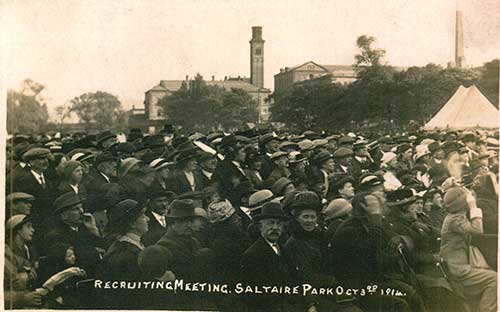
Click here for larger image
|
House History (up to 1918) – 3 Fern Place
- 1871 – William Wood (b1838 Huddersfield) Weaving Overlooker with wife & eight children (House built as No2 – renumbered between 1876 – 1881).
- 1881 to 1910 – Robert Heaton (b1851 Sutton in Craven) Mill Engine Fitter with wife & one daughter. Robert died 16 June 1910.
- 1911 to 1915 – Elizabeth Heaton (nee Child, b1846 Doncaster) widower of Robert.
- 1918 – Edith Anderson, (nee Fillingham b1870 Lincoln) widower of Arthur.
|
HMS Aboukir HMS Aboukir was a Cressy-class armoured cruiser built for the Royal Navy around 1900. Upon completion she was assigned to the Mediterranean Fleet and spent most of her career there. Upon returning home in 1912, she was placed in reserve. Re-commissioned at the start of World War I, she played a minor role in the Battle of Heligoland Bight a few weeks after the beginning of the war. Aboukir was sunk by the German submarine U-9, together with two of her sister ships, on 22 September 1914; 527 men died aboard the ship.
|
| John R. Fyfe and Co of Shipley Fire Brick Works, Shipley, Yorks

- 1874 Company established.
- 1914 Fire brick and sanitary earthenware manufacturers. Specialities: fire bricks for puddling and rolling mill furnaces, cupola furnaces and suction gas plant furnaces; lump, ground and pugged fire clay, boiler seating blocks, boiler float bricks, quarries, singe plate bricks, sanitary pipes, traps, gullies, dishes, flue linings, air grates, junction and invert blocks, chimney pots, tiles. Employees: office, 5. (Source 1914 Whitakers Red Book)
Info: Graces Guide
One of many firms who donated to Saltaire Hospital.
|
Rutherford, Tom Thompson Middleton (1899 – 20 July 1918)
Colin Coates writes: On Friday 11th July 2014, I received an email from a Lars Ahlkvist, a medal collector from Sweden. He had acquired Tom Rutherford’s medals (with their box of issue). On Thursday 10th July, Lars and his wife were in France and they decided to visit Tom’s grave. Lars writes:-
“We drove from Reims, and arrived in a slight drizzle. We placed the medals on the headstone, and observed a short silence for Tom and all the victims on both sides. Marfaux is adjacent to a German cemetery, where many died on same dates in July 1918. The cemetery is a concentration cemetery. Tom was originally buried at Cuitron British Cemetery, a short distance from Mardfaux. The 6th stage of Tour de France passed from Arras to Reims in honour of the centenary, and the President of France attended somewhere along the route to pay his respects.”
Lars took a photograph and he was kind enough to forward it to me. Many thanks.
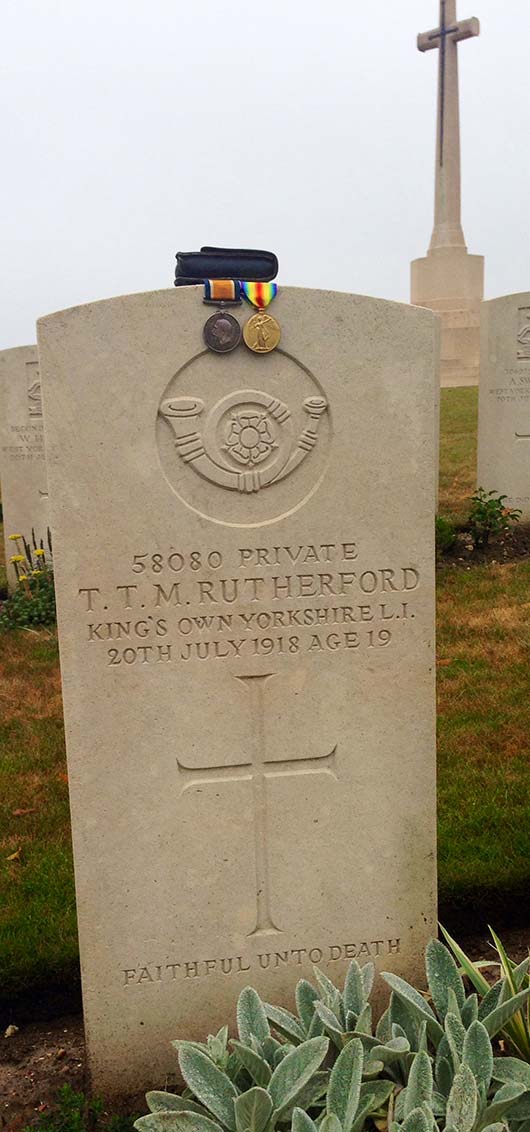
Photograph courtesy of Lars Ahlkvist, 2014.
Tom Thompson Middleton Rutherford – Update
Colin Coates writes: “On Tuesday 15th July, Lars contacted me. He has been in contact with Deborah, a grandniece of Tom’s and she has passed on to us a photograph of Tom and of a medal of his. (Many thanks to Deborah for allowing us to publish the photographs on our web site). Lars is going to send Deborah the medals he has in his possession; as Lars says “they are better off with the family.”
The photographs, below, of Tom Rutherford and his medal, were shared by Deborah Burns, Tom's grandneice.
Deborah Burns writes: “Tom has never been forgotten in our family and my grandmother to whom I was very close, never really got over the death of her baby brother. She named her only child, my father, Tom (middle name Rutherford) in his memory. Tom, my Dad, served as a bomber pilot in the RAF during WW2 and although suffering horrific injuries in a Mosquito crash in 1942, used to say he was at least lucky enough to have come home, unlike his namesake.
Both wars shaped our family lives as they did the lives of many, on both sides of the conflict and I think it right to remember and respect the sacrifices made. My two children have always been fascinated to hear stories of wartime experiences (in my Dad’s case, often amusing tales!) from anyone civilian or service and I am sure will pass this on to any of their subsequent offspring.”
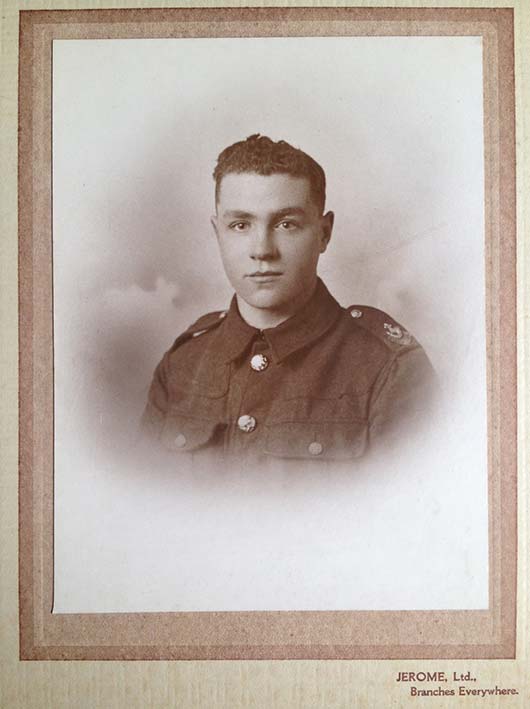
Tom Thompson Middleton Rutherford
Image of Tom, above and his medals, helow, courtesy of Deborah Burns,
grandniece of Tom Rutherford.
 Mouse over images below to enlarge. Mouse over images below to enlarge.
|
| The Prince of Wales Fund
On 7th August 1914, H.R.H. the Prince of Wales made an urgent appeal in The Times:
"Buckingham Palace - all must realise that the present time of deep anxiety will be followed by one of considerable distress among the people of this country least able to bear it. We must earnestly pray that their suffering may be neither long nor bitter, but we cannot wait until the need presses heavily upon us. The means of relief must be ready in our hands. To ally anxiety will go some way to stay distress. A National Fund has been founded, and I am proud to act as its Treasurer. My first duty is to ask for generous and ready support, and I know that I shall not ask in vain. At such a moment we all stand by one another, and it is to the heart of the British people that I confidently make this earnest appeal. Edward."
|
Work at Salts Mill, December 1914: Booming!
Colin Coates: The attached quote from a local newspaper, 4th December 1914, shows that despite the war business for the mill is booming. We know that at the outbreak of the war just 4 months earlier the mill was put on short time working. What we don't know is what changed in that short time to warrant full employment and indeed overtime.
"Not since the outbreak of the war has trade been so good in Shipley district as it is at present. Saltaire Mills illuminated at night tell their own tale. Four or five hundred workpeople are putting in overtime, and practically the whole of the remainder of the three thousand employees at these great mills are now working the usual hours. Another instance of the improved demand for labour was found this week, when the District Council officials required fifty men for excavation work in connection with the laying of a new water main in Moorhead Lane. They could only obtain half the number of men they wished to employ."
|
Has Anyone Seen a German Band
(Song sung by the British Troops in the trenches)
Once a little German girl lonely and sad,
Came to merry England from her Fatherland.
Looking for her sweetheart whose front name was Fritz,
And he played the Trombone in some German Band:
She searched round the City by night and by day.
And asked evry one on the way.
Has any one seen a German Band?
German Band, German Band.
I've been looking about all upon my own.
I've searched ev'ry street both near and far,
near and far, yah, yah, yah.
I want my Fritz, vot plays twiddly bits on der big trombone.
"Fritz was very fond of me," Katrina said.
"When he was in Germany over the seas;
And he used to come round to mine Fader's house,
He'd make love and eat all our Limburcheese.
He'd serenade me with 'The watch on the Rhine',
And I thought his trombone divine."
Has any one seen a German Band?
German Band, German Band.
I've been looking about all upon my own.
I've searched ev'ry street both near and far,
near and far, yah, yah, yah.
I want my Fritz, vot plays twiddly bits
on der big trombone.
"Perhaps you wonder why I am over here now."
Said the little Katrina. "I'll tell you true.
There's another girl and she's stolen my Fritz,
She gives him sweet kisses, and saurkrout too;
But wait till I meet him, I'll get back mine own,
I'll jump two times on his trombone."
Has any one seen a German Band?
German Band, German Band.
I've been looking about all upon my own.
I've searched ev'ry street both near and far,
near and far, yah, yah, yah.
I want my Fritz, vot plays twiddly bits on der big trombone
|
HMS Kent
HMS Kent was one of 10 Monmouth-class armoured cruisers built for the Royal Navy in the first decade of the 20th century. She was placed in reserve when completed in 1903, but was recommissioned for the China Station in 1906. She remained there until she returned home in 1913 for a lengthy refit.
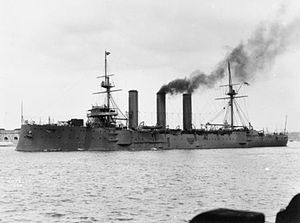
HMS Kent
At the beginning of World War I in August 1914, she was still refitting. In October Kent was ordered to the South Atlantic to join Rear Admiral Christopher Cradock's squadron in their search for the German East Asia Squadron, but arrived at the Falkland Islands after the British squadron had been destroyed in the Battle of Coronel. During the subsequent Battle of the Falkland Islands, the ship sank a German light cruiser. Several months later she discovered the sole surviving German ship from that battle and forced Dresden to scuttle herself in the Battle of Más a Tierra. She was briefly assigned to the China Station in mid-1915, but returned home several months later to begin convoy escort duties until mid-1918 when she returned to the China Station. In early 1919 the ship was deployed to Vladivostok to support the Siberian Intervention during the Russian Civil War. Kent was sold for scrap in 1920.
|
Lord Derby’s Scheme
The Derby Scheme was a voluntary recruitment policy in Britain created in 1915 by Edward Stanley, 17th Earl of Derby. The concept behind the Derby Scheme was that men who voluntarily registered their name would be called upon for service only when necessary. Married men had an added incentive in that they were advised they would be called up only once the supply of single men was exhausted.
The scheme was also referred to as the "Group System" as men were classified in groups according to their year of birth and marital status and were to be called up with their group when it was required.
The scheme proved unsuccessful and was abandoned in December 1915, in spite of the fact that the execution of Nurse Edith Cavell by the Germans, on 12 October 1915 was used in recruitment rallies by Lord Derby. It was superseded by the Military Service Act 1916 which introduced conscription.
215,000 men enlisted while the scheme was operational, and another 2,185,000 attested for later enlistment. However, 38 per cent of single men and 54 per cent of married men who were not in 'starred' occupations failed to come forward.
|
Three Armies
During WW1, there were three distinct British Armies. The "first" army was the small volunteer force of 400,000 soldiers, over half of which were posted overseas to garrison the British Empire. This total included the Regular Army and reservists in the Territorial Force. Together, they formed the British Expeditionary Force (BEF), which was formed for service in France and became known as the Old Contemptibles.
The 'second' army was Kitchener's Army, formed from the volunteers in 1914–1915 destined to go into action at the Battle of the Somme.
The 'third' was formed after the introduction of conscription in January 1916, and by the end of 1918, the army had reached its maximum strength of 4,000,000 men and could field over 70 divisions.
The vast majority of the army fought in the main theatre of war on the Western Front in France and Belgium against the German Empire. Some units were engaged in Italy and Salonika against the Austro-Hungarian Empire and the Bulgarian Army, while other units fought in the Middle East, Africa and Mesopotamia—mainly against the Ottoman Empire—and one battalion fought alongside the Japanese Army in China during the Siege of Tsingtao.
|
| |
| Keep up-to-date on Twitter
 Saltaire Website on Twitter. Saltaire Website on Twitter.
Colin Coates: colincoates@saltairevillage.info |
| |
| |
|
|
|
|
|
